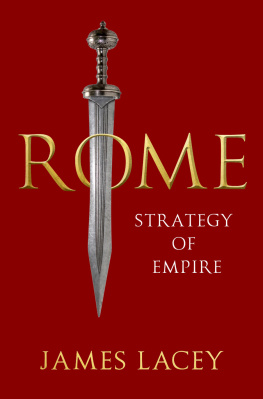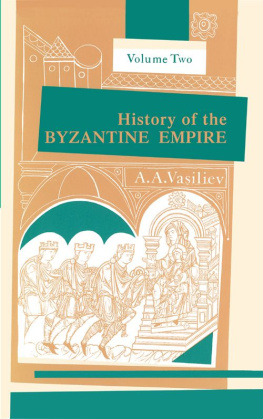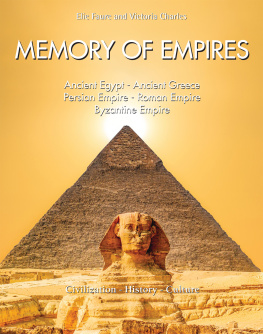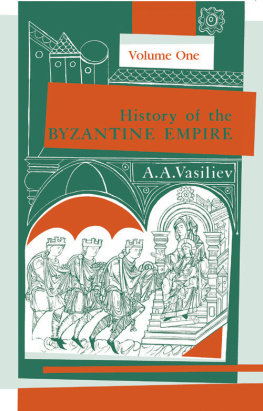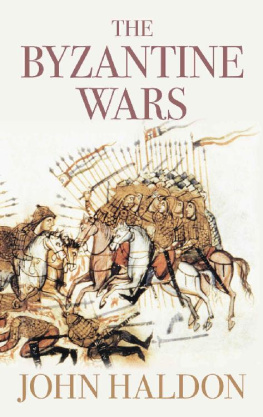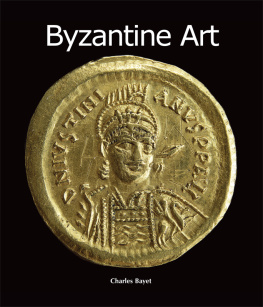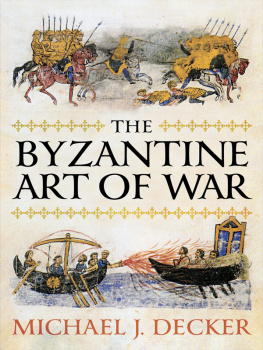Table of Contents
Copyright 2009 by the President and Fellows of Harvard College
All rights reserved
Printed in the United States of America
Library of Congress Cataloging-in-Publication Data
Luttwak, Edward.
The grand strategy of the Byzantine Empire / Edward N. Luttwak.
p. cm.
Includes bibliographical references and index.
ISBN 978-0-674-03519-5 (cloth : alk. paper)
1. Byzantine EmpireMilitary policy. 2. StrategyHistoryTo 1500. 3. Military art and scienceByzantine EmpireHistory. 4. ImperialismHistoryTo 1500. 5. Byzantine EmpireHistory, Military. 6. Byzantine EmpireForeign relations. I. Title.
U163.L86 2009
355.033549500902dc22 2009011799
Preface
Once largely neglected, as if the entire Roman empire had really ended in 476, the eastern half that we call Byzantine by modern habit now attracts so much attention that it is even the subject of popular histories. While many are interested in the culture of Byzantium, it is the epic struggle to defend the empire for century after century against an unending sequence of enemies that seems to resonate especially in our own times. This book is devoted to one dimension of Byzantine history: the application of method and ingenuity in the use of both persuasion and forcethat is to say, strategy in all its aspects, from higher statecraft down to military tactics.
When I first started to study Byzantine strategy in earnest, I had just completed a book on the strategy of the Roman empire up to the third century that continues to attract both inordinate praise and strenuous criticism. My original intention was simply to write a second volume to cover the subsequent centuries. What ensued instead was the discovery of an altogether richer body of strategy than the earlier Romans had ever possessed, which called for a vastly greater effort of research and composition. In the end, this lasted for more than two decades, albeit with many interruptionssome due to my not entirely unrelated work in applying military strategy in the field. There was one compensation for this prolonged delay: several essential Byzantine texts once available only as scarcely accessible manuscripts, or in antiquated editions replete with errors, have now been published in reliable form. Also, a considerable number of important new works of direct relevance to Byzantine strategy have been published since I started on my quest long ago.
For in recent years Byzantine studies have indeed flourished as never before. A great wave of first-class scholarship has illuminated many a dark corner of Byzantine and world historyand it has also inspired a climate of high-spirited generosity among the practitioners. Although I am more student than scholar in this field, I have experienced this generosity in the fullest measure.
Soon after I started reading for this book, circa 1982, George Dennis, whose translation of the Strategikon is the most widely read of Byzantine military texts, gave me an advance typescript of his work that would be published as Three Byzantine Military Treatises. Twenty-six years later, he sent me a typescript of part of his eagerly awaited edition of Leos Taktika, which I urgently needed to complete this book; generosity is mere habit for George T. Dennis of the Society of Jesus. Walter E. Kaegi Jr., whose works illuminate the field, also gave me valuable advice early on.
Others whom I had never even met, but simply importuned without prior introduction, nevertheless responded as if bound by old friendship and collegial obligations. Peter B. Golden, the eminent Turcologist amply cited in these pages, answered many questions, offered valuable suggestions, and lent me two otherwise unobtainable books. John Wortley entrusted me with the unique copy of his own annotated typescript of Scylitzes. Peter Brennan and Salvatore Cosentino offered important advice, while Eric McGeer and Paul Stephenson and Denis F. Sullivan, whose work is here conscripted at length, read drafts of this book, uncovering errors and offering important advice. John F. Haldon, whose writings constitute a library of Byzantine studies in themselves, responded to a strangers imposition with a detailed critique of an early draft.
Because what follows is intended for non-specialists as well, I asked two such, Anthony Harley and Kent Karlock, to comment on the lengthy text; I am grateful for their hard work, considered opinions, and corrections. A third reader was Hans Rausing, not a specialist but a profound and multilingual student of history, and to him I owe valuable observations. Stephen P. Glick applied both his encyclopedic knowledge of military historiography and his meticulous attention to the text, leaving his mark on this book. Nicol Miscioscia was my able assistant for a season. Christine Col and Joseph E. Luttwak researched and graphically prepared all the maps, no easy task amidst endless revisions. Michael Aronson, senior editor for social sciences at Harvard University Press, was the active proponent of my earlier book on Roman grand strategy a long time ago. It was with unending patience over two decades that he asked for this book as well, and his experienced enthusiasm is manifest in the physical quality of the publication, an effort in which he was ably assisted by Donna Bouvier and Hilary S. Jacqmin of the Press. It was most fortunate that they commissioned Wendy Nelson to serve as manuscript editor. With infinite care and talented discernment she uncovered many a stealthy error, and gently indicated infelicities in need of remedy. Finally, it is a pleasure to thank Alice-Mary Talbot, also here cited, Director of the Dumbarton Oaks Research Library and Collection, and the always helpful Deb Brown Stewart, Byzantine studies librarian at Dumbarton Oaks. I might have dithered forever instead of finally composing the text had I not met Peter James MacDonald Hall, who demanded the book and removed the excuse of all other work.
PART ONE
The Invention of Byzantine Strategy
When the administration of the Roman empire was divided in the year 395 between the two sons of Theodosius I, with the western portion going to Honorius and the eastern to his brother Arkadios, few could have foretold the drastically different fates of the two halves. Defended by Germanic field commanders, then dominated by Germanic warlords, increasingly penetrated by mostly Germanic migrants with or without imperial consent, then fragmented by outright invasions, the western half of the empire progressively lost tax revenues, territorial control, and its Roman political identity in a process so gradual that the removal of the last imperial figurehead, Romulus Augustus, on September 4, 476, was mere formality. There were local accommodations with the invaders in places, even some episodes of cultural integration, but the newly fashionable vision of an almost peaceful immigration and a gradual transformation into a benign late antiquity is contradicted by the detailed evidence of violence, destruction, and the catastrophic loss of material amenities and educational attainments that would not be recovered for a thousand years, if then.
Very different was the fate of the eastern half of the Roman empire commanded from Constantinople. That is the empire we call Byzantine by modern habit though it was never anything but Roman to its rulers and their subjects, the romaioi, who could hardly identify with provincial Byzantion, the ancient Greek city that Constantine had converted into his imperial capital and New Rome in the year 330. Having subdued its own Germanic warlords and outmaneuvered Attilas Huns in the supreme crisis of the fifth century that extinguished its western counterpart, the Byzantine empire acquired the strategic method with which it resisted successive waves of invaders for more than eight hundred years by the shortest reckoning.
Next page


